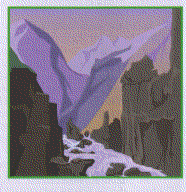
One of the interesting studies available to students of geology is the way in which various structures on the surface of the earth are formed. Our cover shows some beautiful mountains, but the unusual field of sand dunes is what probably catches most people's eyes first. Where does sand come from and what message does it carry for us. Where we live in the Great Lakes area, there are massive amounts of sand. Areas to the south of us have lots of rocks, but relatively small amounts of sand compared to our area. This has not always been true, however, because deep underground there are massive amounts of sandstone--the same sand we have around the Great Lakes, but cemented together into rock.
Sand can be produced by the smashing up of rock. In places like Hawaii, there are beaches made up of black lava pounded by waves into sand. There are even green and pink beaches made from parent rock that contains minerals like olivine with their colors. Most sand, however, is made of quartz and is the by-product of the breakdown of volcanic rocks. Granite is made up of three basic minerals--orthoclase, hornblende, and quartz. There can be smaller amounts of other materials, but these are the dominant ones. The interesting thing is that these minerals have different hardness levels and are eroded at different rates. Orthoclase is quite easy to erode and has a pinkish color to it. This material is seen as clay when it is deposited in significant amounts. Hornblende is also fairly easy to weather and erode and is dark colored. Quartz is extremely hard and durable. The result is that when weather and physical processes work on granite, the orthoclase and hornblende are carried away and what is left is quartz (sand).
The massive amounts of sand seen around the Great Lakes has come mainly from the granite that makes up the Canadian shield--the bedrock underlying much of North America. Any mountainous area will ultimately be reduced to nothing more than sand. One lesson that comes from mountains and sand is that nothing in this physical world is permanent. Jesus stated this eloquently when He urged us to "Do not store up for yourselves treasures on earth where moth and rust destroy, and where thieves break through and steal. But store up for yourselves treasures in heaven, where moth and rust do not destroy, and where thieves do not break in and steal. For where your treasure is, there your heart will be also.
When I took my geology classes at Notre Dame University, we had a professor
who would take us on a field trip to the cemetery. Headstones erected in
the early 1800s already have disintegrated into piles of sand. One has
to be reminded of James
4:14, "For what is your life? It is even a vapour, that appeareth for
a little time, and then vanisheth away."

Another lesson from mountains and sand is the message of change. One of my favorite places on Lake Michigan near our home is called Tower Hill. This huge dune of sand is an active, moving dune. A parking lot on the lakeside of the dune has cut off its sand supply, and as the dune erodes away from wind and people climbing on it, old layers of soil and buried trees are emerging. Hundreds of miles to the south of our area are buried sand dunes, indicating that ancient granite areas must have been nearby and very different conditions must have existed than do now.
The Bible is a book of change. In Genesis, we see man change and we see the world change with him. Over and over, God says "from now on" in reference to things that would change (see Genesis 3:14, 16-19). As you read the Bible, you see man change and the continual change in how God deals with man. All of this culminates in the greatest change of all--the death of Christ, His resurrection, and the establishment of His Church. As we see the Church grow and adjust in Acts, we see more change; and the book of Revelation clearly shows change in the future.
Through all of this, however, is the message of purpose and design by God. The mixture of sand, hornblende, and clay lead to soil. Life could not exist on a planet made of unweatherable and unerodable rock. The waters that erode the granite sustain life, and the result of all of this produces the topsoil that feeds us. The change of mountains into sand makes the earth a vibrant, living thing of beauty.
So too, our lives can be things of beauty if we allow God to mold and shape us. This is one of the key messages of 1 Corinthians 15:39-55. As the writer tells us of the most beautiful changes of all:
Behold, I shew you a mystery; we shall not all sleep, but we shall all be changed. In a moment, in the twinkling of an eye, at the last trump: for the trumpet shall sound, and the dead shall be raised incorruptible, and we shall be changed. For this corruptible must put on incorruption, and this mortal must put on immortality. So when this corruptible shall have put on incorruption, and this mortal shall have put on immortality, then shall be brought to pass the saying that is written, Death is swallowed up in victory. O death, where is thy sting? O grave, where is thy victory? (1 Corinthians 15:51-55).
Back to Contents Does God Exist?, SepOct01.